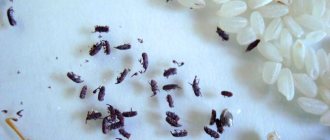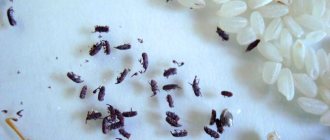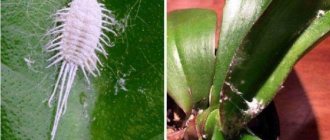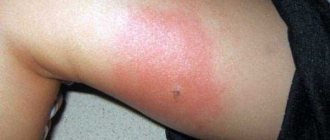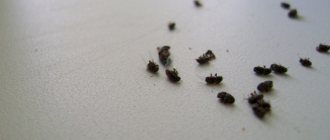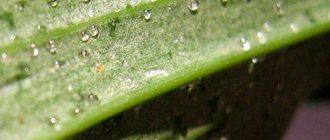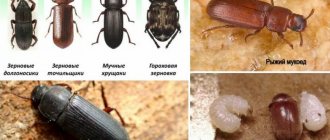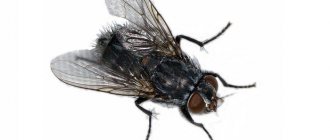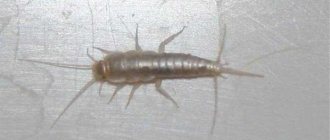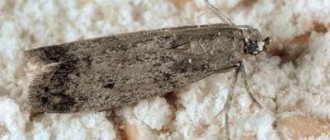In recent years, all amateur gardeners growing lilies have encountered a serious problem. Its cause and other troubles are associated with the massive spread of voracious red bugs of a large family of Leaf Beetles , the genus Lilioceris .
Cute rattle beetles are active and incredibly voracious
Two common types ruin our lives. This is, first of all, onion rattle , bulbous , or bulbous daylily (L. merdigera). The lily beetle , or lily rattle , and lily beetle (L. lilii), known as the " fireman ", also cause damage. The pest eats away the leaves so much that often only the stem remains of the plant. Then there can be no talk of any flowering.
Last summer I began to notice these red bugs on the wide leaves of the imperial hazel grouse and daylily. They are just looking at these plants for now. Lilies of the valley are not touched either.
Spider mite
A well-known pest that feeds on the sap of young shoots. Forms huge colonies and can “suck” the plant to death. The first signs of infection are the leaves starting to curl. If you look at them closely, you can see small red dots - these are ticks.
Control measures. Treat the plants with any acaricide, for example “Aktellik” or “Fitoverm”. The main thing is to do this as early as possible, while there are few pests.
Squeak beetle (bulbous rattle)
An incredibly beautiful beetle, but very harmful. Females lay pink larvae on the leaves, which eat the leaves clean. You won't have to look for them for long - they are clearly visible.
Control measures. Treat the plants with Karbofos, Inta-Vir or Decis according to the instructions.
Medvedka
This “beast” eats up the roots, bulbs and shoots of lilies. The pest can be detected by numerous holes in the soil.
Control measures. The easiest way is to add Grizzly, Medvetox or Grom preparations to the soil according to the instructions.
Another option is to set up traps for the mole cricket. For example, dig small holes and fill them with manure. Or place small pieces of slate in the flower garden - pests love to hide in such places. From time to time, traps need to be checked and insects destroyed.
Onion hoverfly
If in late spring - early summer, while caring for lilies, you hear a quiet murmur, look around. Do you see small black flies hovering over the flowerbed? Know that your flowers are in danger. These are onion hoverflies and they have most likely already laid eggs in the soil. Soon the larvae will appear, which with an exorbitant appetite will bite into the bulbs and turn their insides into a putrefactive mass.
Control measures . Before planting, dust the bulbs with Bazudin. During the mass summer of flies, treat the plants with Karbofos or Inta-Vir. And in the fall it is necessary to dig up the soil and mulch the lilies with peat.
Wireworms (larvae of click beetles)
This typical potato pest also happily eats lily bulbs. As a result, the bulbs rot and the plants die.
Control measures. Wireworms are especially common in acidic soils, so before planting lilies in such areas, you need to add lime or wood ash. Once every 2 weeks, it is useful to water the plants with potassium permanganate (3–5 g per 10 liters of water). Among the drugs, Provotox, Medvetox, Vallar and Pochin help well.
Description of the pest
The fire beetle belongs to the Leaf Beetle family and poses a great threat to the leaves of the flower. Today, two types of pests are often found: onion rattle and lily rattle. Insects eat a lot of foliage; sometimes you can find a plant with a bare stem.
- Onion rattle
. This pest is a member of the leaf beetle with a bright red body and head. Thanks to its powerful jaws, the pest can eat not only foliage - its prey is the buds, flowers and stem of the plant. The main targets of leaf beetles are lilies of the valley and lilies. That is why they have another name: “lily beetle”. - Lily rattle
. Another pest of lilies is the so-called red beetles. They have a rather attractive appearance and have rigid wings. People call such pests “firemen” because of their colors. They have an oblong red body and a black head.
Often children catch and place insects in a small box - while doing so, a cracking sound can be heard from it, which gives the name to the pests.
What do soldier bugs eat?
Soldier bugs feed on the same things as other insect pests. Their comfortable existence is ensured by the cellular sap of plants. The beetles obtain it by piercing the stems of shoots or leaves with their proboscis.
Fire bugs have other sources of food:
- vegetables.
- Berries.
- Fruits.
After exposure to soldiers, the fruits of bushes and trees become unsuitable for consumption.
If there are no plants nearby, the wingless red bug is able to feed on carrion, gathering in numerous groups.
Harm in the garden
Leaf beetles moved to summer cottages relatively recently: back in the 90s they lived exclusively in forests. Today, the lily beetle is found quite often in the garden, and you need to know how to deal with it.
About a week after the eggs are laid,
pink larvae appear. They are located under the leaf, so they are quite difficult to notice right away. The larvae are very voracious and can eat all the leaves on a flower, leaving only the stem.
After 2-3 weeks they move to the soil, where they begin to transform into orange pupae. After 3 weeks, the red pests go hunting. For the winter they hide in the ground or fallen leaves.
Introduction
The stem and leaves of the plant are attacked by onion rattle, lily rattle, thrips, and 15 species of aphids, as well as slugs, snails and centipedes.
Lily bulbs are damaged by mole crickets, bulbous hoverflies, wireworms, bulb mites, cockchafers and mouse-like rodents (mice).
The roots can be eaten by long-legged mosquitoes or caramors (lat. Tipulidae). Sometimes the flower can even be damaged by squirrels and deer.
Among all possible pests, we have described the most common ones, which occur in 90% of cases of flower problems.
Pests of lilies
The nutritious bulbs of a flowering plant, its stems, leaves and inflorescences are loved not only by rodents, but also by small pests - insects. Lilies are attractive and common plants, but to successfully grow them you need to familiarize yourself with all the agrotechnical rules and take into account the fact that they cause an unhealthy interest in insects.
To successfully combat pests, it is necessary first of all to correctly determine the “personality” of the pest and, based on this, select treatment.
What do you need to know about "firemen"?
Beetles belong to the family of leaf beetles.
Their appetites are enormous. They devour not only lilies, but also hazel grouse, tobacco, plants from the nightshade family, especially potatoes, and in nature they live on lilies of the valley. Hostas and hollyhocks are often damaged. Beetles, and to a greater extent their larvae, eat leaves, buds, and flowers. They are very voracious and their harmfulness can even be compared to the Colorado potato beetle. They have practically no enemies among insects that would restrain their populations. When danger approaches, they deftly fall to the ground and make chirping noises to scare the enemy.
Over the course of a season, beetles and their larvae can destroy an entire lily plantation, the bulbs of which will go to winter weakened and may not even bloom the next season. In the worst case, the bulbs do not overwinter and die.
Pests of lilies and their control
It so happens that insects love to feast on all varieties of lilies. Today there are 15 main pests that affect lilies. In this case, one must take into account the fact that they can not only eat all fragments of the plant, but also carry various diseases.
The most dangerous pests for lilies are presented below.
Red beetles on lilies
Red beetles on lilies
There are red bugs on lilies, how to get rid of them? This problem is quite common and occurs if a flower lover does not follow the rules of crop rotation in the flowerbed and does not carry out preventive irrigation of the bushes.
Has alternative popular names:
- squeak beetle,
- bulbous rattle,
- lily beetle.
It is quite easy to find due to its bright red color; the larvae are pink and covered with a special protective mucus that inhibits plants.
The main symptoms of damage are the wilting of the plant; it is very easy to see insects and their larvae on the aboveground part of the crop.
Spider mite
A pest that drinks all the juices from a plant, causing it to wither.
Important! A terrible feature of the insect is that the eggs of the species are able to live in the soil for more than 5 years and are highly resistant to many drugs.
The main symptoms of the lesion are the gradual drying of the bush, the leaves curl, and the buds fall off. If you look closely, you can see threads of cobwebs, many white eggs and adults on the leaves.
Caterpillars on lilies
This is a real problem that can lead to the death of the plant.
The insect lives in the soil and overwinters there. When the bush is damaged, it begins to literally eat flowering shoots and bulbs.
The greatest damage is caused during the rainy period and in areas where a large amount of weeds grow, since butterflies lay eggs exclusively on weeds.
Rodents
How to protect lilies from rodents in the country? These questions concern everyone without exception, since rodents severely damage the plant. As a rule, after such damage it simply dies.
How to plant lilies without being eaten by mice? There is one simple but proven method - before planting the bulb, treat it with diluted Vishnevsky ointment. By the way, this treatment also protects the plant not only from rodents, but also from some insects and diseases.
Other pests
Less common “lovers” of lilies:
- The lily fly attacks uncolored lily buds. The defeat will become more obvious when the entire inside of the bud is eaten, and the fly quietly pupates in the soil.
- The Colorado potato beetle is an insect that lays its larvae on the back of the leaf blade; this happens from June to August. In the near future, the eggs hatch into young individuals that infect all fragments of the aboveground part of the lily.
- Slugs. Black slugs appeared on the lily - the picture, of course, is not a pleasant one. Moreover, the plant soon begins to fade before our eyes. Mollusks become active in rainy and humid weather and affect all above-ground parts of the plant. Getting rid of them is not so easy, since fungicides and insecticides are effective against insects, but not against molluscs.
- Thrips are dangerous because they suck all the juices out of crops. Silver spots always form in their habitat (this is perhaps one of the most obvious signs of damage). Next, insects penetrate the buds, as a result, the latter, before they have time to open, become discolored and fall off. They overwinter in lily bulbs; if the air temperature does not drop below +10 degrees, they remain active. Affected bulbs are usually covered with a red dense crust.
Thrips
In some cases, the root system of lilies is parasitized by small insects that have an elongated shape. They are called thrips. Their mouthparts look like a proboscis. These pests pierce the plant tissue and suck the juice out of it. After this, the plant weakens greatly, and its appearance loses its attractiveness. But the most dangerous thing is the transmission of various viral diseases by thrips. In a year, these parasites can form from three to eight generations. All this depends on the type of pest, as well as on the temperature and humidity of the environment. The number of generations becomes significantly smaller if the ambient temperature decreases. This is primarily due to an increase in the life cycle.
These insects can be controlled using any systemic insecticide. This could be, for example, “Karbofos” or “Fitoverm”. They begin to process plants with the arrival of spring. Subsequently, processing is carried out every ten or twelve days.
All lily pests, photos and descriptions of which are presented in this article, are the most common and frequently encountered in garden plots. But this does not mean at all that our list is exhausted. In addition to the insects discussed, there are others that infect these plants less frequently and also carry various diseases of viral and non-viral origin. But this is not a reason to despair and refuse such beautiful flowers on your site. The main thing is to study the available information and carry out preventive and therapeutic measures in a timely manner. Then your daylily will look wonderful and delight your eyes with bright and healthy flowers.
Treatment methods and prevention
Many gardeners are wondering how to treat lilies against diseases and pests. Fortunately, today there is a huge selection of special chemicals designed to combat them.
- The red beetle is fought with a solution of Karbofos (0.2%) or any other insecticidal preparation (for example, Decis, Intra-Vir).
- Measures to combat spider mites are limited to the use of a soap solution or Karbofos solution (0.2%). It is necessary to thoroughly irrigate the plant and its surrounding area with the solution, treating the leaves especially well.
- To combat the lily fly, the insecticidal preparations indicated above are also used.
- To get rid of the Colorado potato beetle and its young, it is recommended to treat the bushes and the soil around it with a solution of Karbofos (0.2%), alternatively, you can use other insecticides. With the onset of autumn, it is important to deep dig the soil and mulch it with peat. The next year, before planting the bulbs in the soil, the flower bed is treated with Bazudin (disinfectant powder).
- To combat caterpillars, it is necessary to promptly remove all weeds and carry out deep digging of the soil every autumn. The plant and soil are irrigated with insecticidal emulsions.
- To combat slugs, it is recommended to use traps - this is the most reliable means. Making them is quite simple; you need to take small boards and immerse them in water so that they absorb moisture. Next, the prepared material is laid out near the lily bushes, and a wet cloth is placed under the boards. Now the traps must be checked daily, slugs collected and immediately destroyed. In dry weather, the soil around the plant can be treated with red pepper, ash and superphosphate. As for chemicals, Metaldehyde is effective.
- To combat aphids and thrips, concentrated insecticidal solutions or solutions of insecticidal plants are used, these include potato and tobacco tops.
In general, the modern chemical industry offers many effective drugs that are quite capable of coping with any misfortune.
Preventive actions
It is much easier not to get rid of the problem, but to prevent it.
To protect lilies, tulips and other flowers in a flower bed, you should follow all the preventive procedures described below:
- Before planting, the bulbs must be treated with disinfectants (for example, Prestige, Maxim).
- In addition, the planting material must be visually inspected - the bulbs must be moderately hard and elastic, and there must be no traces of mechanical damage on the surface, as well as diseases and pests.
- Lilies are light-loving flowers, so the area should be well lit. Growing in partial shade is possible, but you will not be able to see lush flowering. Also, do not forget that many insects also prefer partial shade.
- Lily plantings in the garden should not be thickened. Otherwise, it will not be possible to avoid the development of fungal diseases, rotting of the root system and, accordingly, pest damage.
- In the fall, when digging up bulbs, the procedure should be carried out with extreme caution so that their integrity is not compromised.
- Lilies are moisture-loving crops, so the frequency and abundance of watering should be optimal. Watering should be done at the root, early in the morning or late evening, using warm water.
- In the spring, after the first leaves bloom, the bush should be sprayed with copper oxychloride.
- During storage of bulbs, it is necessary not only to strictly observe all storage rules, but also to inspect them for pathologies. It is important that the room is well ventilated.
- Potassium-phosphorus mineral fertilizers can prevent insect damage.
- Crop rotation is an important factor in preventing the development of diseases and pests.
- It is recommended to plant marigolds and garlic between the rows to repel insects and rodents.
- To introduce fertilizers into the soil, use only those mineral complexes that are intended specifically for lilies.
- Regular soil treatment with formaldehyde is necessary.
- In autumn, all plant remains must be removed in a timely manner. It is recommended to burn them and use the ash as fertilizer.
- After each work with crops, it is necessary to disinfect the equipment used.
- In the fall, deep digging of the soil should be done.
Every agronomist should be aware that there are a large number of pests around that want to feast on lilies. It is more effective not to fight the problem, but to prevent it, but if the plant is affected, then in order to save it, you must use one of the control methods described above.
Folk remedies
For opponents of chemical treatment, there are a number of traditional methods of combating the red beetle.
- Collect mechanically. You can catch the beetles themselves (it is convenient to place the caught ones in a container with soapy water) or look for their clutches, and subsequently the larvae (they are small, so it will be easier to remove them from the leaves with pieces of soft paper or fabric). The method is complicated by the fact that the beetles, when they see danger, immediately fall to the ground with their belly up, and it becomes difficult to see them.
- Shake beetles and larvae from bushes onto cardboard or polyethylene laid on the ground.
- Douse with a stream of water. But both the beetles and a significant part of the larvae will soon crawl back onto the plant.
- Spraying with natural solutions or infusions (dry mustard, ash, laundry soap, wormwood, etc.). This will scare away adult insects from the plantings, but not destroy them. Some of the larvae that have just hatched from the eggs die. Treatment is carried out at least once a week.
- Pollination with dry ash or mustard.
- During the season, cover the ground under the bushes and between the rows with film (this will also save you from weeds). The larvae will not be able to burrow into the ground for further development.
However, lilies will have to be treated in this way against red beetles many times over the course of a season. It is better to combine them, since none of these methods will bring the desired effect the first time.
Lifestyle, nutrition
The squeak beetle is active in the warm season - from May to August. The mating season begins at the end of spring, larvae begin to appear in June, and by the end of August a new generation of young adults emerges. The lily beetle lives in numerous colonies and prefers lilies of different varieties. When there is a lack of food, it settles on hazel grouse, lilies of the valley, and weeds.
Lily beetle
It is active during the day and sits motionless on plants at night. The larvae live on the underside of leaves, hiding from direct sunlight. Some species of birds feed on adult beetles. The main enemies for the larvae are ground wasps. They lay eggs on the body of a living victim, after a few days the young appear and begin to eat it from the inside.
The red beetle has a good appetite. Within a few days of living on the plant, the lily begins to wither, ache, and fade. If you do not respond to the problem in a timely manner, the flower dies. In addition to lilies, the red-backed onion beetle feeds on potatoes, tobacco, onions, and hazel grouse.
The red lily beetle pest lives for several seasons. With the onset of cold weather, young individuals burrow into the ground, tolerate frosty winters well, crawl to the surface in the spring, begin to mate, and lay eggs. By the end of August they die, leaving the young generation, the pupae, to overwinter.
Where do little red bugs come from?
Since the wingless red bug is accustomed to a humid and fairly warm climate, its natural habitat can be designated as the tropics and subtropics.
North America, North Africa, temperate Eurasia - these are the areas where the small soldier feels quite comfortable.
It is difficult to say exactly where red bugs come from in our latitudes. However, due to the peculiarities of their structure, parasites are quite adaptive. Even once they get into a person’s home, they can easily find food for themselves in the form of indoor plants.
To prevent pest infestation of the garden, it is worth cleaning the area in a timely manner. Elimination of rotten stumps and old trees, as well as periodic disinsection, will help get rid of unpleasant parasites.
How to deal with red bugs on lilies
What to do if red beetles appear on lilies depends on the number of pests, personal preferences of gardeners, and the size of the flowerbed. Folk and chemical remedies will help save the plant from death.
How to treat lilies against red beetles
When there are large numbers of pests, experts recommend using insecticidal preparations with contact-intestinal action. You can use any means to bait Colorado potato beetles, most often they use:
The lily beetle is resistant to other poisons. The solution must be prepared immediately before use. Spray flowers in the evening or early in the morning in dry weather. The pests die within a day, the protection remains valid for 20 days.
Physical methods
The fight against red bugs continues throughout the warm season. Every week the plant is inspected and pests are collected manually. On large plots of land, the procedure is complicated by the fact that when the pest sees danger, it falls to the ground, turns over with its back down, hides its bright back, and merges with the soil.
The red-winged beetle prefers certain crops, searches for food based on the strong aroma of flowers, and finds them several kilometers away. After harvesting, the lily rattle needs to be destroyed or released away from the flower beds.
You can get rid of the red beetle on lilies mechanically in a few weeks, but you need to collect not only the adults, but also the larvae. Unpleasant creatures hide under the leaves.
Adult
The most common and studied species is the onion rattle or Lilioceris merdigera.
This onion leaf beetle is a beetle whose thick body is up to 7.5 mm long. The head is large in size with a raised forehead. The frontal part is limited by narrow deep grooves and divided by a longitudinal smooth groove.
Characteristic are very convex eyes located on the sides of the head capsule. A prominent constriction located behind the eyes floats onto the crown. The rounded pronotum can be longitudinal or square and has a notch in the middle segment. The pygidium has a stridulatory apparatus.
A distinctive feature of the spaced claws is their strong curvature. The claws are spaced and strongly curved. The reddish color gives way to black, which covers the abdomen, legs and knees. The antennae can be entirely black, black with a red ring, or entirely red. The elytra are wider than the pronotum.
